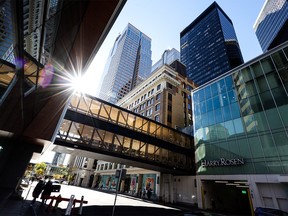
From A to Z — Airdrie to Zama City — Albertans are feeling the sting of soaring inflation, with prices shooting up by 6.2 per cent in September from a year ago.
While the economy continues to grow and more people move here, a new report by the Business Council of Alberta makes the case that spiralling bills are hammering people in Wild Rose Country harder than in the rest of the country.
“Albertans are suffering more from inflation than other Canadians,” it states.
The reason? Sluggish growth in wages.
“Businesses are struggling to find workers and, despite tight labour markets, Alberta has seen the weakest wage growth of any province over the last two years,” says the council’s quarterly economic snapshot released Tuesday.
“As a result, inflation is hitting harder here than elsewhere in Canada as price increases chip away at affordability.”
The uncertain state of Canada’s economy, along with sky-high inflation and rising interest rates, have become pressing issues across the country this year.
On Wednesday, Statistics Canada reported the annual national inflation rate jumped by 6.9 per cent in September, increasing the likelihood of another steep interest rate hike to cool down prices.
In Alberta, the Consumer Price Index increase came in slightly above the six per cent mark reported in August, but second lowest among the provinces.
“Everything is up, right from nuts and bolts,” said Greg McIvor, who operates McGyvors Machine Services in the northern Alberta community of Zama City.
“We have to travel 165 kilometres just to get our groceries, and so when you throw the higher food prices on to that, and then the gas to go there and back, it’s affecting everybody.”
Recommended from Editorial
-

No longer a one-trick pony, perception of oil-town Calgary is changing
-

Recession proof? Alberta economy expected to avoid Canadian GDP shrinkage
-

Inflation, worker shortages put growing squeeze on Calgary businesses: survey
-

‘Good news’: Alberta’s unemployment rate dips to lowest mark since 2015
-

‘A real turnaround’: Alberta continues population gains from across Canada
High energy prices have been one of the main drivers of rising bills in the country, although surging shelter and food costs are also squeezing consumers.
In Alberta, strong oil and natural gas prices provide some buffer from the economic turbulence.
Provincial economic growth is widely expected to outperform the rest of the country this year and in 2023, according to experts at the Calgary Economic Development outlook event on Wednesday.
Alex Grassino, managing director at Manulife Investment Management, told reporters he anticipates the country will slip into a recession by the end of this year or in early 2023. He said inflation remains “stubbornly strong,” even with interest rates climbing.
“The bottom line is that we’re looking at it almost like a racetrack. Every single (report) we get for inflation that stays high extends how much longer the Bank of Canada is going to have to keep increasing” interest rates, he said.
Alberta’s economy is projected to grow by three per cent in 2023, with strong commodity prices allowing the province to weather the storm in better shape than other parts of Canada, said ATB deputy chief economist Rob Roach.
The key problem for many Albertans, and millions of Canadians, is that their paycheques simply aren’t keeping up with expenses.
In July, average weekly earnings in the province rose 1.8 per cent from a year earlier to $1,239 — still the highest in the country — while the national average was $1,153, up 2.9 per cent.
The Business Council of Alberta report points out that wages in Canada have climbed seven per cent over the past two years, while they’ve increased by less than one per cent in Alberta.
“Alberta’s wage premium is shrinking,” it stated.
In part, this is because employment growth in the province has been stronger in lower-paying sectors and weaker in higher-paying industries, the report states.

Council chief economist Mike Holden pointed out that employment is growing, outpacing the rest of the country.
The province is facing labour shortages, with about 100,000 open positions.
“We are not seeing wages keep pace with inflation in Alberta — and the gap is much wider in Alberta than it is elsewhere in the country, so we’re losing ground faster through price increases,” Holden said in an interview.
One encouraging sign is the number of people considered to be long-term unemployed (without a job for a year or more) has also fallen sharply since April 2021.
Meanwhile, almost 10,000 more Canadians moved into Alberta than left the province in the second quarter.
University of Calgary economist Trevor Tombe noted that during the 2015-16 downturn, the province saw layoffs and wage reductions throughout that period, followed by stagnant pay increases in 2018.
As the pandemic hit, a steep recession hammered Alberta in 2020, before the current upturn.
“Alberta earnings are still higher, but the difference between Alberta and the rest of the country is much, much smaller than it used to be,” Tombe said.
ATB’s Roach said lower wage increases underscore the restructuring that took place in the oil and gas sector in recent years.
“It also reflects that up until recently, we had high unemployment, higher than the national average,” he said. “We might see some more wage growth now that Alberta’s economy is picking up.”
For anxious consumers and businesses, they’re feeling the pricing pinch now.
In September, shelter costs rose more than six per cent and food purchased from stores jumped 9.7 per cent in the province.
John Sikking, a vice-president and co-owner of IHOP restaurants in the province, said the company has increased wages for cooks in the past eight months to respond to a tight labour market.
The more vexing issue for the business is volatile utility and food bills.
“You print your menu and then two or three weeks later, you see a five per cent increase here, you see a 10 per cent increase there,” Sikking said.
“It’s tough right now, especially when the target keeps moving.”
Chris Varcoe is a Calgary Herald columnist.
You can read more of the news on source
